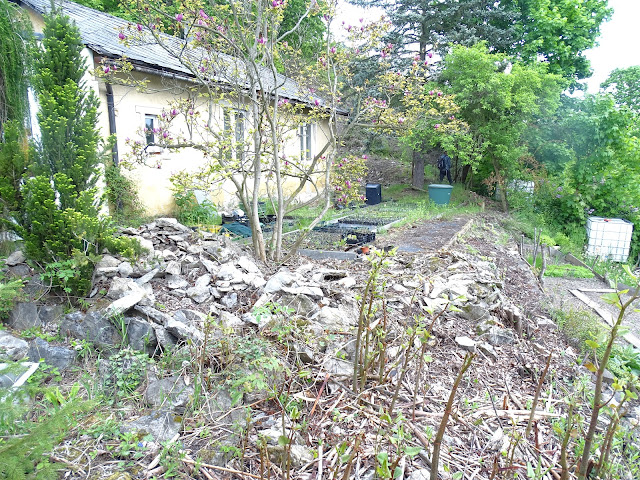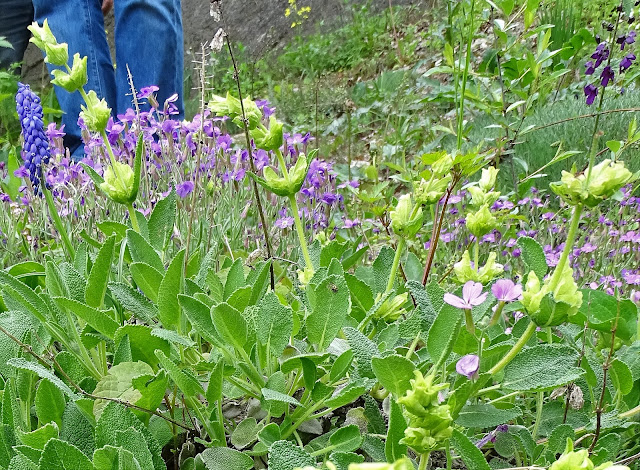For various reasons (which I frankly didn't quite understand) the man who created this garden is no longer tending it: there was construction taking place in part of it. Maybe it had been sold? All I know is that the pictures you're saying may be some of the last taken here, which should give them a certain added poignance...
I shall not drone on in every picture to identify plants I don't really know for sure what the names are... you can guess as well as I can at the Iris above, the Muscari off to the left, the Asperula (or is it an Androsace? on the right). You get the drift. I shall recognize a few here and there that I can I.D.--but the point isn't the individual plants so much as the extraordinary drifts of wonderful plants, the soaring Karst cliffs, and the exquisite perfection that is doomed. Maybe they worked things out and he'll be back?
Here you can see where I photographed the polygala that was in the first frame. And notice the dense mounding Buxus dead center. Choice silver saxifrages (S. longifolia hybrids, or just callosa?) And the crevice style rockwork here...
Thick wads of gesneriads--Haberlea rhodopensis--who knows what color forms.
Cushions and mounds everywhere....a handsome buckwheat at 3:00PM above...
 |
| Numerous maidenhair spleenworts in this shot (Asplenium trichomanes) |
I'm assuming this is an Edraianthus: there are an amazing variety of these that the Czechs have introduced from the Balkans. I dare not venture a guess...
 |
| Buried among the spleenworts appears to be Viola delphinantha. Looking very happy. |
A fantastic clump of Androsace: of the villosa group no doubt.
Sic transit Gloria mundi.
The various color forms of Ramonda are to die for....
What daphne is that above, and what the heck is the groundcover below? And is that a Euphorbia lower middle? If so which one?
 |
| Matthiola anchonifolia (or is it sempervirens?) |
A completely different color form of this Turkish sprite.
 |
| Coluteocarpa versicaria |
Dandelions moving in...
A white flowered Onosma I've never seen before...
I love the dwarf lilac and the rosy echo next to it...which I'm sure is Anthyllis montana 'Rubra': I grew it for years. And here it is in this quietly doomed garden.
I'm pretty sure this is Eriogonum heracleioides dead center. But what are all the treasures around it?
Another view of the same vignette...
I've grown this Turkish Centaurea (may still have it)--but there are several look alikes. Won't venture a guess. I can pretty much guaranteee the flowers will open yellow!
I'm pretty sure this is Cytisus demissus from Mt. Olympus in this shot. I've seen it on that mountain.
 |
| Scilla littardieri perhaps? |
 |
| Pulsatill albana or perhaps regeliana with a dwarf linum next door. |
 |
| Ceterach officinarum |
Not sure what the verdant drift of woodlander might be, but notice the gesneriads in and hart's tongue fern in the gully...
 |
| More gesneriads (Haberlea in various color forms) and scrumptious ferns. |
 |
| A fantastic drift of Adiantum venustum from the Himalayas. |
And a picture perfect clump of Eriogonum caespitosum from our American West.
Three delightful clumps of very condensed boxwood. With some of the infernal construction going on behind...
More drifts of various gems...
Not sure which Veratrum this is--probably nigrum (it wouldn't be blooming until July)...
 |
| And a perfect little Dianthus. Not sure which species, alas. |
 |
| I believe this is the European form of Cryptogramma crispa. More delicate than ours. |
 |
| Pinus heldreichii 'Schmidtii' |
Masses of gesneriads wherever you look on the shady cliffs.
Not sure which Ramonda on the left, and a stunning specimen of Saxifraga, probably cochlearis.
Where the nursery once was...
An attenuated Acantholimon on the right, growing out of a crevice, and another Cryptogramma crispa on the left.
One of my heros on the left: Josef Jurasek, who accompanied us on this visit: examining some petrophile.
An Allium. Wish I knew which. Notice the Cyclamen seedlings scattered about?
A strange and splendid Verbascum with green cut foliage. Cohabitating with acantholimons on various sides--this is in a more steppe-like open meadow.
A wonderful tangle of gems in the steppe: Aubrieta, acantholimons, a Salvia...
A Turkish Salvia, won't venture a guess: allied to S. cryptantha but much taller. I would love to grow this...
 |
| Looks to be Matthiola trojana. But there are others like it in Greece as well as Turkey. |
An American buckwheat I don't recognize. Huge Acantholimons behind...
Another shot of this same spot--with spleenworts growing alongside the cushions! And a flat cotoneaster. Dictamnus albus behind about to bloom.
We saw this crevice garden before, another show....
I have this for my friend, Bill Adams--who has a fondness for the little buckthorns: this is a monster!
I love the purple Japanese Maple brooding over the tragic scene.
Hard to believe the garden had been left to its own devices: still looking pretty pristine in this shot.
These Ramonda obliged us with bloom.
 |
| And a dwarf Polygonatum unlike any I grow. And I grow a half dozen little ones. |
The pathway out...
A sign describing the unique natural environment where this garden nestled. Much of which is preserved...but this garden, alas, may only persist in memory. I hope I'm wrong!
(Final thoughts: I am deeply grateful to the Czech Rock Garden conference for inviting me to attend this fantastic conference last spring. The privilege of seeing so many of these great rock gardens is one that shall haunt me until such time as I return again. I have published accounts of two thus far on Prairiebreak...and intend to do more as winter stretches ahead...do mark your calendar for 2021 when they'll be planning yet another conference!).

























































A remarkable garden... sad if it is lost..
ReplyDeleteHard to enjoy all that beauty knowing how fragile its continued existence is.
ReplyDeleteSuch a beautiful and interesting garden, even without being cared for. It will be sad if it is totally lost.
ReplyDeleteWhile looking through old issues of the Rock Garden Quarterly I found an article by Waid Vanderpoel. I had met Tom and thought he might be related. When I asked him, Tom informed me Waid was his Dad. Tom said, “At one time his rock garden was one of the best in the world.”
ReplyDeleteI asked Tom, “If his garden is still in existence, I would like to visit if possible.”
Tom wrote, “Unfortunately the garden no longer exists. Rock gardens exists do to passion of the gardener and when he (or she) is no longer around they fade quickly.”
In memory of Tom Vanderpoel (8/8/2017)
http://www.chicagotribune.com/suburbs/lake-zurich/news/ct-bcr-tom-vanderpoel-obit-tl-0817-20170809-story.html
Thanks for posting the link to the tribute to Tom: he spoke truly. I visited Waid's garden and it was truly fantastic. The giant troughs there ultimately inspired our trough plaza at DBG (which alas has also gone the way of all things). Gardens are very much an expression of the moment--even if they take years to be made! Life is like writing on water.
DeleteIt would be terribly sad to lose that garden. It is gorgeous. But gardens have been lost and found before. It just needs someone with a similar passion or A garden trust.
ReplyDelete